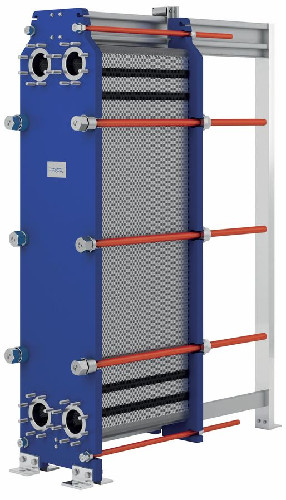Plate Heat Exchanger Re-Rating
Economical, Safe, and Thermally-Efficient Re-Rating Services for Your Plate Heat Exchanger
A key feature of gasketed plate-and-frame heat exchangers is the ability to add or remove plates as needed in the event of a change in process conditions or to repurpose the unit for a new duty altogether. For example, increased production in a manufacturing plant, an increase of servers in a data centre, or an increase in tenants in a building will each increase the cooling load of a plate-and-frame heat exchanger in its respective application. It is also possible for an existing unit to lose effective surface area due to fouling over the course of its lifetime. Regardless of the reasoning, it is important that the re-rating of gasketed plate-and-frame heat exchanger units is performed based on design expertise while using thermodynamic, mechanical, and chemical principles in order to avoid unintended negative repercussions.
At Valutech, we offer the expertise of designing and re-rating heat exchangers for virtually every industry in which they are used, including the HVAC, steel manufacturing, automotive, mining, pharmaceutical, chemical and petrochemical processing, aerospace, plastics, food and beverage production, renewable power generation, ethanol and biofuel/biodiesel production, fuel cell manufacturing, depolymerization, metal finishing, furniture manufacturing, and textile industries. We use our software and practical experience to determine what changes, if any, need to be made to an existing of gasketed plate-and-frame unit in a re-rating scenario, or whether a new unit must be selected to fulfill the specified duty.

In addition, while the number of plates in brazed and fusion bonded plate heat exchangers cannot be modified, Valutech can determine whether a given unit can be used in an application with a modified or new duty. The duty of any heat exchanger is limited either by thermal constraints or mechanical (pressure drop) constraints — optimal designs result in satisfaction of both thermal and pressure drop specifications while preserving factors such as connection velocities and the ratio of the connection pressure drop to channel pressure drop at an ideal level. Therefore, the optimal design of a plate heat exchanger for effective heat transfer requires balancing high-velocity turbulent flow with the pressure drop that can be overcome by the system’s pump.

Put simply, the relationship between the number of plates in a given plate-and-frame unit and the duty it is capable of achieving is not linear — the number of plates (as well as the plate pattern and the dimensions of the unit) is based on a number of factors, including the temperature profile and pressure drop restrictions of the application. That is, it is essentially impossible to increase the capacity of a given unit by 30% by increasing the number of plates by the same amount.
Consider for example a condominium in Toronto furnished with a gasketed plate-and-frame heat exchanger rated for 350 tons (1230 kW) of cooling. In addition to cleaning the existing plates within the unit, the responsible organization also installed plates until the frame capacity of the unit was met. As a result, the unit in question was unable to provide sufficient cooling for the condominium after two years of operation under these circumstances. Furthermore, the fouling that was observed after 2 years was significantly more severe than the fouling that occurred within the first 15 years of operation with the originally specified number of plates.
In any plate heat exchanger, turbulence is a key contributor to effective heat transfer, since convectional heat transfer forces strengthen as a function of turbulence. Another factor to consider in plate heat exchanger design is the wall shear stress, a measurement of the force the fluid exerts tangentially to the flow direction on the plates. It is created by the friction that results from fluid flow along the plates. Shear stress results in a force that keeps particulates suspended in the flow stream, which is useful in fouling applications where there is a concern of particulates adhering to the plates. The target wall shear stress in a fouling application is approximately 50 Pa, which is commonly achieved at a pressure drop of 70 kPa (10 psi).
The addition of plates to a unit with an identical flow rate reduces fluid velocity in each of the channels between the plates, thus leading to a reduction in turbulence and heat transfer ability. It also decreases the shear stress on the plates, leading to an increased rate of fouling, which itself compounds in the loss of heat transfer ability as a result. In the case of single-pass plate heat exchangers, which account for the majority of industrial units and nearly the entirety of HVAC units, this can result in short-circuiting of the fluid flow, where the plates furthest from the connections receive relatively less flow.
This phenomenon further exacerbates fouling concerns in a situation where a gasketed plate-and-frame unit is not re-rated correctly. In such cases, re-designing the unit with optimal plate geometry allows for the use of the same unit while reducing deviations from the newly-specified duty.
Generally, it is suggested that an increased duty is accompanied by a corresponding increase in flow rate, to the point where the flow rate is suitable for the connection size of a given plate-and-frame unit — beyond this absolute limit in flow rate, the heat exchanger must be replaced.

It is also possible to modify the log-mean temperature differential of the application in order to achieve a higher capacity with a fixed fluid velocity; this is valid until the thermal limit of the unit. Caution must also be taken when re-rating for a smaller capacity than originally designed for; a reduction in plates with an identical flow rate will lead to a higher pressure drop, resulting in higher process energy consumption, assuming the pump is rated for the resulting head in the first place. Regardless of the circumstances surrounding the re-rating of your plate heat exchanger, Valutech has the expertise to recommend a safe and economical solution in order to meet the heat transfer needs of your application.
